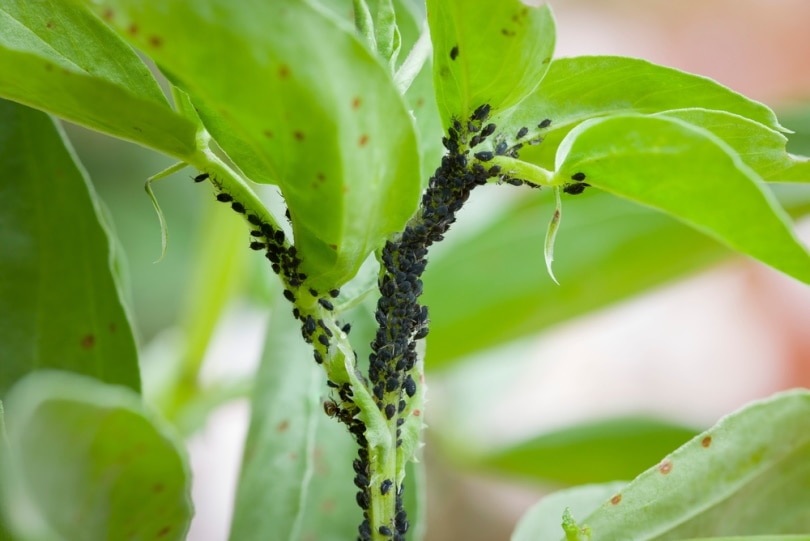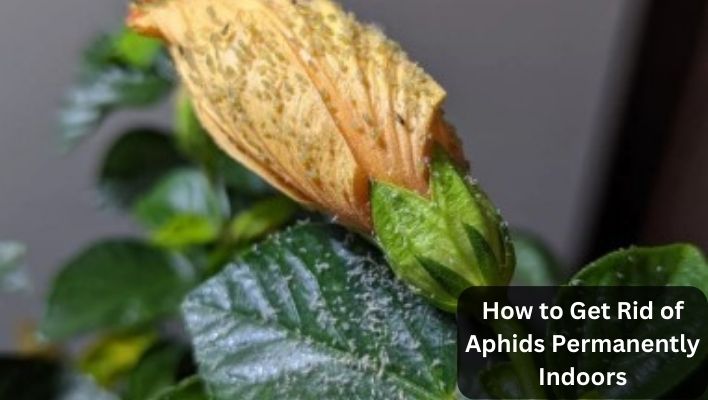Understanding the Aphid Menace: Identifying the Problem and Its Impact
Aphid infestations can be a significant problem for indoor plants, causing damage and disrupting the plant’s growth. To effectively address this issue, it’s essential to understand the common signs of aphid infestation and the risks associated with it. When learning how to remove aphids from indoor plants, it’s crucial to recognize the signs of infestation, including curled or distorted leaves, sticky substance on leaves, and the presence of white, cottony patches.
These signs can indicate the presence of aphids, which can be found on the stems, leaves, and flowers of plants. Aphids can be green, yellow, black, or white, and may be found in clusters or alone. In addition to the physical signs of infestation, aphids can also spread plant viruses, which can have devastating effects on indoor plants. Some common plant viruses spread by aphids include the tobacco rattle virus and the potato virus X.
Aphid infestations can also attract other pests, such as ants and wasps, which can further exacerbate the problem. To prevent the spread of disease and the attraction of other pests, it’s essential to address aphid infestations promptly. By understanding the signs of infestation and the risks associated with it, you can take the necessary steps to remove aphids from your indoor plants and prevent future infestations.
Preparing for Battle: Essential Tools and Materials for Aphid Control
When it comes to removing aphids from indoor plants, having the right tools and materials is crucial. To effectively eliminate aphids, you’ll need a combination of gentle, non-toxic methods that won’t harm the plant. Some essential tools and materials for aphid control include neem oil, insecticidal soap, horticultural oil, and a soft-bristled brush.
Neem oil is a natural, non-toxic pesticide that can be used to control aphids. It works by disrupting the aphid’s hormone system, preventing them from reproducing and eventually killing them. Insecticidal soap is another effective method for controlling aphids, as it works by breaking down the aphid’s exoskeleton and dehydrating them. Horticultural oil is a refined mineral oil that can be used to control aphids, as it works by suffocating them.
A soft-bristled brush is also an essential tool for removing aphids from indoor plants. This can be used to gently sweep away aphids and their eggs from the plant’s leaves and stems. When using these tools and materials, it’s essential to follow the instructions carefully and take necessary precautions to avoid harming the plant.
When learning how to remove aphids from indoor plants, it’s also important to consider the importance of using gentle, non-toxic methods. Harsh chemicals can damage the plant and even kill it, so it’s essential to opt for natural, non-toxic methods instead. By using the right tools and materials, you can effectively eliminate aphids from your indoor plants and prevent future infestations.
How to Remove Aphids from Indoor Plants: A Step-by-Step Guide
Removing aphids from indoor plants requires a combination of patience, persistence, and the right techniques. To effectively eliminate aphids, follow this step-by-step guide on how to remove aphids from indoor plants.
Step 1: Inspect the Plant – Begin by thoroughly inspecting the plant for signs of aphid infestation, such as curled or distorted leaves, sticky substance on leaves, and the presence of white, cottony patches. Check the undersides of leaves, stems, and flowers, as aphids often hide in these areas.
Step 2: Isolate Infested Areas – Once you’ve identified the infested areas, isolate them from the rest of the plant to prevent the aphids from spreading. Use a soft-bristled brush to gently sweep away aphids and their eggs from the plant’s leaves and stems.
Step 3: Apply Control Methods – Apply control methods, such as neem oil, insecticidal soap, or horticultural oil, to the infested areas. Follow the instructions carefully and take necessary precautions to avoid harming the plant.
Step 4: Monitor and Repeat – Monitor the plant regularly for signs of aphid infestation and repeat the control methods as necessary. It may take several treatments to completely eliminate the aphids, so be patient and persistent.
When learning how to remove aphids from indoor plants, it’s essential to remember that patience and persistence are key. Aphids can be a persistent problem, but with the right techniques and control methods, you can effectively eliminate them and prevent future infestations.
Organic and Chemical Control Methods: Weighing the Options
When it comes to removing aphids from indoor plants, there are several control methods available, including organic and chemical options. Each approach has its pros and cons, and it’s essential to weigh the options carefully before making a decision.
Organic control methods, such as neem oil and insecticidal soap, are generally considered safer and more environmentally friendly than chemical control methods. These methods work by disrupting the aphid’s hormone system or dehydrating them, and are often less toxic to humans and pets. However, organic control methods may require repeated applications and can be more time-consuming to apply.
Chemical control methods, such as pyrethrin and permethrin, are often faster-acting and more effective at eliminating aphids quickly. However, these methods can be more toxic to humans and pets, and may also harm beneficial insects. Additionally, chemical control methods can contribute to the development of pesticide-resistant aphid populations.
When deciding between organic and chemical control methods, it’s essential to consider the severity of the infestation, the type of plant, and the potential risks to humans and pets. In general, organic control methods are recommended for mild to moderate infestations, while chemical control methods may be necessary for severe infestations.
Some popular organic control products for removing aphids from indoor plants include neem oil and insecticidal soap. These products are available at most gardening stores and can be applied according to the product’s instructions. When using these products, it’s essential to follow the instructions carefully and take necessary precautions to avoid harming the plant.
Preventing Re-Infestation: Tips for Maintaining a Healthy Indoor Garden
Preventing aphid re-infestation is crucial to maintaining a healthy indoor garden. By taking a few simple steps, you can reduce the risk of aphid infestation and keep your plants thriving.
Inspect New Plants – Before introducing new plants to your indoor garden, inspect them thoroughly for signs of aphid infestation. Check the undersides of leaves, stems, and flowers, and look for any white, cottony patches or sticky substance.
Use Physical Barriers – Physical barriers, such as fine-mesh screens or fine-netted bags, can help prevent aphids from reaching your plants. Place these barriers around the plants to prevent aphids from crawling or flying onto them.
Maintain Good Garden Hygiene – Good garden hygiene is essential for preventing aphid infestation. Regularly clean and disinfect your gardening tools, and avoid sharing tools between plants. Also, remove any debris or dead plant material from the garden to prevent aphids from hiding and breeding.
Monitor Plants Regularly – Regular monitoring is key to preventing aphid infestation. Check your plants regularly for signs of aphid infestation, and take action at the first sign of infestation. This will help prevent the aphids from spreading and reduce the risk of re-infestation.
By following these tips, you can help prevent aphid re-infestation and maintain a healthy indoor garden. Remember, prevention is key, and taking a few simple steps can go a long way in protecting your plants from aphid infestation.
Common Mistakes to Avoid When Removing Aphids from Indoor Plants
When removing aphids from indoor plants, it’s essential to avoid common mistakes that can lead to unsuccessful removal or even harm the plant. Here are some common mistakes to avoid:
Using Harsh Chemicals – Avoid using harsh chemicals, such as pesticides or insecticides, to remove aphids from indoor plants. These chemicals can harm the plant, contaminate the soil, and even pose health risks to humans and pets.
Over-Watering – Over-watering can exacerbate aphid infestations, as aphids thrive in moist environments. Avoid over-watering your plants, and ensure the soil is well-draining to prevent waterlogged soil.
Neglecting to Inspect the Plant Thoroughly – Failing to inspect the plant thoroughly can lead to missed aphid infestations, allowing the problem to persist. Take the time to inspect the plant carefully, including the undersides of leaves, stems, and flowers.
Not Isolating Infested Areas – Failing to isolate infested areas can allow aphids to spread to other parts of the plant or even to other plants. Isolate infested areas, and treat them separately to prevent the spread of aphids.
By avoiding these common mistakes, you can ensure successful removal of aphids from your indoor plants and prevent future infestations. Remember, patience and persistence are key when removing aphids, and taking the time to do it right will pay off in the long run.
When to Seek Professional Help: Dealing with Severe Infestations
While removing aphids from indoor plants can be a DIY task, there are times when it’s necessary to seek professional help. Severe aphid infestations can be challenging to control, and if left unchecked, can lead to widespread damage and the presence of other pests.
Signs of Severe Infestation – If you notice any of the following signs, it may be necessary to seek professional help:
Widespread damage to the plant, including curled or distorted leaves, and a sticky substance on the leaves.
The presence of other pests, such as whiteflies, spider mites, or mealybugs.
A large number of aphids, making it difficult to control the infestation.
Professional Help – If you’re dealing with a severe aphid infestation, it’s best to seek help from a gardening expert or pest control service. These professionals have the training and experience to effectively remove aphids and prevent future infestations.
They can also provide guidance on how to prevent re-infestation and maintain a healthy indoor garden. Don’t hesitate to seek help if you’re unsure about how to remove aphids from your indoor plants.
Conclusion: Winning the War Against Aphids on Indoor Plants
Removing aphids from indoor plants requires a combination of early detection, gentle removal methods, and preventative measures. By following the steps outlined in this article, you can effectively eliminate aphids from your indoor plants and prevent future infestations.
Remember, patience and persistence are key when removing aphids. It may take some time and effort to completely eliminate the infestation, but with the right techniques and control methods, you can win the war against aphids on your indoor plants.
Don’t let aphids take over your indoor garden. Take action today and protect your plants from these pesky pests. By following the tips and advice outlined in this article, you can keep your indoor plants healthy and thriving, and enjoy the many benefits of indoor gardening.
So, what are you waiting for? Start your journey to an aphid-free indoor garden today, and discover the joy of growing healthy, thriving plants in the comfort of your own home.








:max_bytes(150000):strip_icc()/control-aphids-on-houseplants-1902889-01-f975f4298a274bd2adf1c08c54934527.jpg)